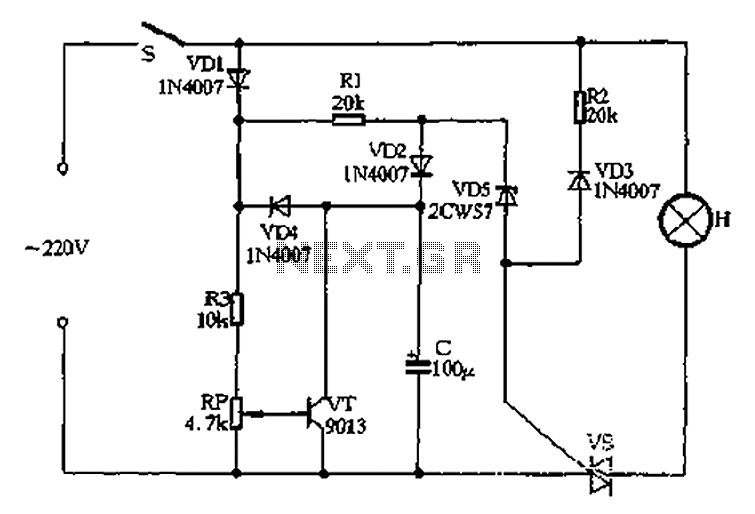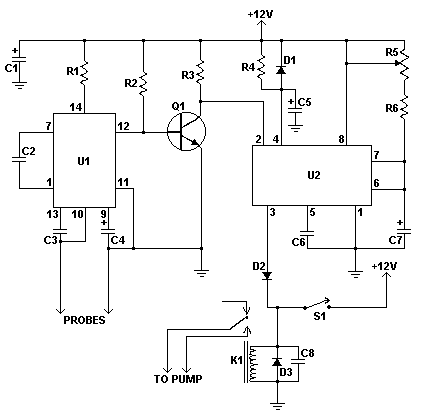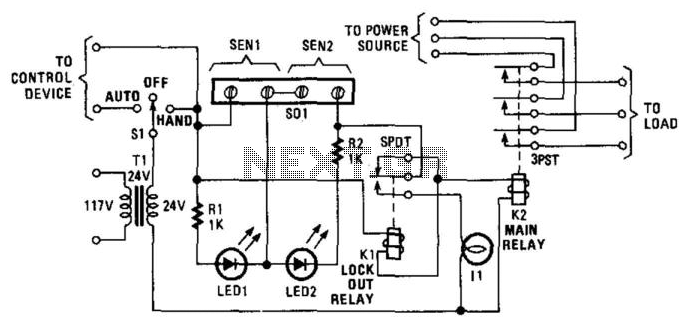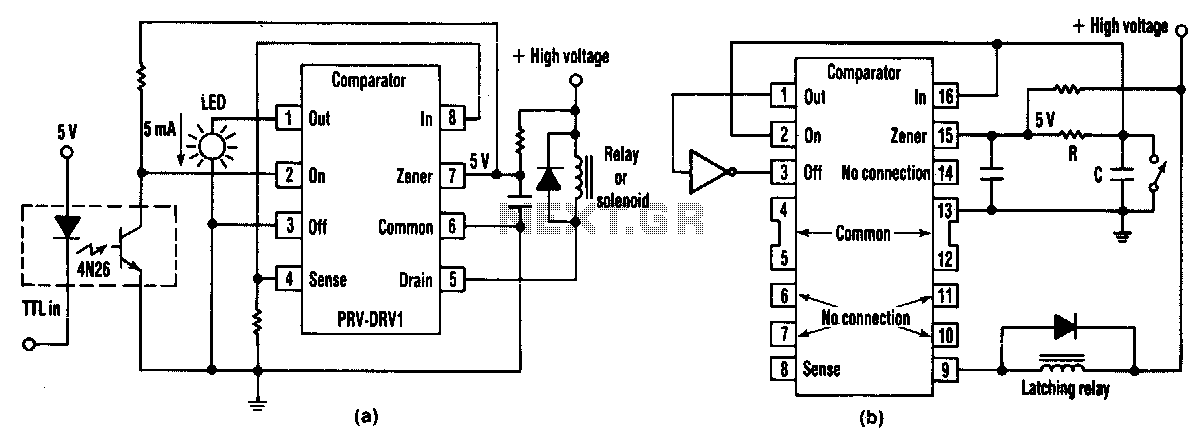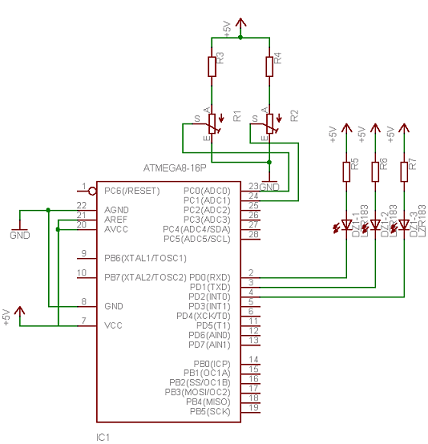
Bass and Tremble Controller ( 741 )
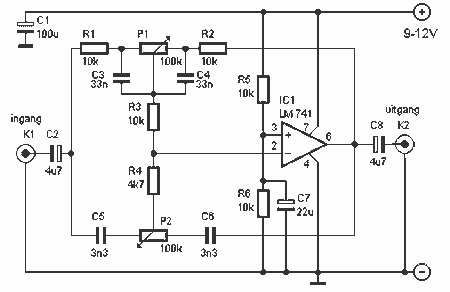
Again, using the versatile IC 741. The feedback of this IC are two T-filters included the strengthening of the treble and bass influence. P1 is responsible for regulating the bass and treble controls P2. Where P1 to the direction of R1 is rotated, the enhanced bass. The circuit boosts the treble when P2 is turned to C6. This should be designing the PCB to be taken into account (normally, the right turn of a potentiometer eenversterking result). This tone control can be switched to different amplifiers. The power supply voltage should be between 9 and 12 volts down, the current consumption is several mA. If one is concerned about the audio quality of this 741 without modification to replace a TL081. More: Parts List R1, R2, R3, R5, R6 = 10 kOhm R4 = 4.7 kOhm P1, P2 = 100 kOhm linear C1 = 100 V ?F/16 C2, C8 = 4.7 V ?F/16 C3, C4 = 33 nF C5, C6 = 3.3 nF C7 = 22 V ?F/16 IC1 = LM 741
The circuit described utilizes the LM741 operational amplifier, configured to create a tone control system that enhances audio signals by adjusting bass and treble frequencies. The design includes two T-filters, which are integral for modifying the audio response. The potentiometers P1 and P2, both rated at 100 kOhm, serve as user controls for bass and treble adjustments, respectively.
When P1 is adjusted, it alters the feedback network involving resistor R1 (10 kOhm), effectively increasing the bass response of the audio signal. Conversely, adjusting P2 modifies the treble response by interacting with capacitor C6 (3.3 nF), allowing for fine-tuning of higher frequency sounds. The circuit is designed to be compatible with various amplifiers, making it versatile for different audio applications.
The power supply requirements for the circuit range from 9 to 12 volts, with a current consumption of several milliamperes, ensuring that it can operate efficiently without significant power draw. The component selection includes resistors (R1, R2, R3, R5, R6 at 10 kOhm and R4 at 4.7 kOhm) and capacitors (C1 at 100 µF/16V, C2 and C8 at 4.7 µF/16V, C3 and C4 at 33 nF, C5 and C6 at 3.3 nF, and C7 at 22 µF/16V), which are crucial for establishing the desired frequency response characteristics.
For applications where audio fidelity is critical, it is noted that replacing the LM741 with a TL081 op-amp may yield improved audio quality, as the TL081 is known for its lower noise and higher bandwidth specifications.
Overall, the circuit is designed for ease of integration into existing audio systems, with careful attention to component values and layout considerations for PCB design to ensure optimal performance and reliability.Again, using the versatile IC 741. The feedback of this IC are two T-filters included the strengthening of the treble and bass influence. P1 is responsible for regulating the bass and treble controls P2. Where P1 to the direction of R1 is rotated, the enhanced bass. The circuit boosts the treble when P2 is turned to C6. This should be designing the PCB to be taken into account (normally, the right turn of a potentiometer eenversterking result).
This tone control can be switched to different amplifiers. The power supply voltage should be between 9 and 12 volts down, the current consumption is several mA. If one is concerned about the audio quality of this 741 without modification to replace a TL081. Parts List R1, R2, R3, R5, R6 = 10 kOhm R4 = 4.7 kOhm P1, P2 = 100 kOhm linear C1 = 100 V ?F/16 C2, C8 = 4.7 V ?F/16 C3, C4 = 33 nF C5, C6 = 3.3 nF C7 = 22 V ?F/16 IC1 = LM 741 🔗 External reference
The circuit described utilizes the LM741 operational amplifier, configured to create a tone control system that enhances audio signals by adjusting bass and treble frequencies. The design includes two T-filters, which are integral for modifying the audio response. The potentiometers P1 and P2, both rated at 100 kOhm, serve as user controls for bass and treble adjustments, respectively.
When P1 is adjusted, it alters the feedback network involving resistor R1 (10 kOhm), effectively increasing the bass response of the audio signal. Conversely, adjusting P2 modifies the treble response by interacting with capacitor C6 (3.3 nF), allowing for fine-tuning of higher frequency sounds. The circuit is designed to be compatible with various amplifiers, making it versatile for different audio applications.
The power supply requirements for the circuit range from 9 to 12 volts, with a current consumption of several milliamperes, ensuring that it can operate efficiently without significant power draw. The component selection includes resistors (R1, R2, R3, R5, R6 at 10 kOhm and R4 at 4.7 kOhm) and capacitors (C1 at 100 µF/16V, C2 and C8 at 4.7 µF/16V, C3 and C4 at 33 nF, C5 and C6 at 3.3 nF, and C7 at 22 µF/16V), which are crucial for establishing the desired frequency response characteristics.
For applications where audio fidelity is critical, it is noted that replacing the LM741 with a TL081 op-amp may yield improved audio quality, as the TL081 is known for its lower noise and higher bandwidth specifications.
Overall, the circuit is designed for ease of integration into existing audio systems, with careful attention to component values and layout considerations for PCB design to ensure optimal performance and reliability.Again, using the versatile IC 741. The feedback of this IC are two T-filters included the strengthening of the treble and bass influence. P1 is responsible for regulating the bass and treble controls P2. Where P1 to the direction of R1 is rotated, the enhanced bass. The circuit boosts the treble when P2 is turned to C6. This should be designing the PCB to be taken into account (normally, the right turn of a potentiometer eenversterking result).
This tone control can be switched to different amplifiers. The power supply voltage should be between 9 and 12 volts down, the current consumption is several mA. If one is concerned about the audio quality of this 741 without modification to replace a TL081. Parts List R1, R2, R3, R5, R6 = 10 kOhm R4 = 4.7 kOhm P1, P2 = 100 kOhm linear C1 = 100 V ?F/16 C2, C8 = 4.7 V ?F/16 C3, C4 = 33 nF C5, C6 = 3.3 nF C7 = 22 V ?F/16 IC1 = LM 741 🔗 External reference
